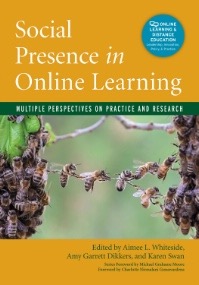teaching strategies
Select an item by clicking its checkbox
While there are moments in the classroom in which trauma prevents learning, to suggest that a traumatized student cannot learn turns the classroom into a space that privileges students who are protected from trauma as a result of being rich, white, male, and heterosexual. Accommodating traumatized students is not just ...
Trauma is like a mirror that we don’t want to look into. It captures us at our worst angles. It accentuates what we want minimized and overlooks what we wish to be prominent. In trauma, we see projected the unwanted aspects of our realities in such a startling way ...

Social Presence in Online Learning - Multiple Perspectives on Practice and Research
Date Reviewed: December 12, 2017
As post-secondary institutions, theological schools continue to participate in various forms of online learning, and the criticism (or question), “It’s not really the same as being in a classroom with a real instructor” is commonly heard. The simple reply to this concern is the concept of social presence. Starting with the initial definition of social presence from Short, Williams, and Christies (1976), this compilation of articles attempts to summarize the historical perspectives and present the current state of discussion, recognizing the constant updating of online course options.
The authors successfully present the historical perspectives, grouping them in three broad categories – as technologically facilitated, as learners’ perceptions, and as critical literacy. However, the chronological and developmental approach leaves the reader realizing the earlier chapters have minimal application to current teachers and learners since the understanding of social presence and the technology used have changed so dramatically. The initial discussions about social presence whether through computer-mediated communication or later within the community of inquiry framework were informative, but the reader quickly realizes that the later frameworks and models have improved. Thus the earlier discussions in the book are of little value for today’s teaching-learning environment. In essence, only the last section is relevant, except as historical background.
The editors demonstrate their breadth of knowledge of the literature and are involved with and connected to the latest research in social presence. A useful chapter (11), “Cultural Perspectives in Social Presence,” provides valuable guidelines for communicating effectively in a multi-cultural learning context. Multiple examples explain how one subset of students find an online learning activity contributes positively to social presence while those of another culture find it impacts social presence negatively. Variations in anonymity, informal chat, self-disclosure, trust building, and conflict resolution are considered. The chapter concludes with useful tips for monitoring and mediating communication which could be misunderstood because of cultural differences.
Likewise, various practices for building social presence into discussions, feedback, and interactions are shared throughout the book. The literature reviewed includes a range of educational levels from K-12 and post-secondary as well as a range of disciplines. The final section provides interesting chapters (17 and 18) about the future of online learning and incorporates social presence into various models of instruction. They suggest social media tools enable instructors to incorporate cohesive and affective elements into courses to enhance social presence. The authors conclude, “Never stop learning because life never stops teaching” (210).
The information shared is relevant for any faculty member teaching online, including theological and religious studies professors. While the final chapters contain valuable tips as noted above, I cannot recommend the book as a whole since it is predominantly a historical overview of the concept of social presence. Though it contains various up-to-date strategies in the closing chapters, it was tedious for the reader to sift through the detailed literature for meaningful insights.
The car service arrived at my house. I grabbed my purse, suitcase, and briefcase and hurried out the door making sure it was locked behind me. As scheduled, we stopped to pick up a colleague who was also attending the conference in Toronto, Canada. Driving east on Highway 78 and almost ...
As finals week draws near, Dr. Roger Nam of George Fox University, Dr. Eric Barreto of Luther Seminary, and Dr. Kate Blanchard of Alma College discuss how they, as teachers and educators of theology and religion, prepare to give final exams.


